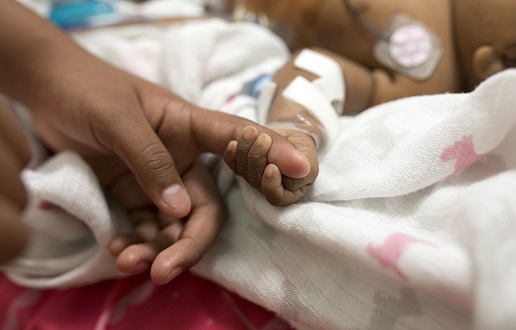
Two new studies from Rady Children’s Institute for Genomic Medicine (RCIGM) find that parents and doctors of critically ill infants view first line sequencing as beneficial, whether or not a definitive diagnosis is achieved. The studies were both part of the second Newborn Sequencing in Genomic Medicine and Public Health (NSIGHT2) study and were published in early November in The American Journal of Human Genetics.
This groundbreaking research into stakeholders’ experiences with sequencing in the NICU provides another justification for incorporating sequencing as standard care of critically ill infants with undiagnosed conditions. RCIGM is one of the world’s leading centers for rapid genomic sequencing of infants and children with serious undiagnosed diseases.
“(Thousands of) conditions can be diagnosed using sequencing,” says David Dimmock, M.D., senior medical director for RCIGM, lead author of one paper, and a contributing author on the other. However, there has been little research into how parents and clinicians of infants who have undergone sequencing view the process. The results, say the Rady researchers, were surprisingly positive.
The sequencing part of the study used the Illumina Novoseq 6000 and both whole-exome sequencing (WES) and whole-genome sequencing (WGS) were used. Results were confirmed using Sanger sequencing, chromosomal microarrays, or other methods, and were typically returned, on average, in 12 days. A total of 213 infants were enrolled, but those considered very ill were tested and excluded from the study.
“In the case of babies who received genomic sequencing, we surveyed their physicians and parents and found that both groups overwhelmingly felt that genetic testing was beneficial,” says Stephen Kingsmore, M.D., DSc, president & CEO of RCIGM. “When results are positive, sequencing reveals the genetic variation responsible for the child’s disease. But what astounded us was the high proportion of both doctors and parents who perceived that this testing had life-changing utility, even in cases when results were negative for genetic disease.”
All of the cases for these two studies were from Rady’s own ICU, although the NSIGHT project encompasses other sites as well. This study included 201 infants who received rapid genomic sequencing. The physicians found genomic sequencing medically useful 93% (42 of 45 cases) of the time when the test was positive—or helped to make a diagnosis. When the test was negative, sequencing was also deemed useful 72% (112 of 156) of the time. According to the physicians, rapid genomic sequencing improved outcomes for 32 infants in the study. Changes in the patient’s management were more likely when test results were returned rapidly.
Parents also had an overwhelmingly positive view of genomic testing in the ICU setting. Of 161 parents whose children received sequencing, 97% reported that the testing was useful. Only two parents reported that testing increased their stress or confusion. Overall, in 81% of the cases, families and their clinicians agreed that genomic test results were useful. Besides seeing the testing as beneficial, parents were mostly satisfied with the process. The authors of the paper on parents’ responses wrote, “Most parents in this study perceived being adequately informed to consent, understood their child’s results, and denied regret or harm from undergoing sequencing.”
As part of the study, “Findings that explained the hospitalization were always returned,” notes Dimmock, “and actionable off-target findings were also returned if requested.”
Not surprisingly, positive results were viewed as more useful and beneficial than negative results. But families who did not get positive results were eligible for follow-up that might include additional sequencing if warranted.
“These studies clearly show that genomic sequencing can be done safely in the NICU, leading to improved communication between families and their healthcare teams,” says Dimmock. “These results underscore the importance of rapid test results in changing care.”
The patients’ clinicians, typically a neonatologist or pediatric intensivist, were the ones who reported test results to the parents. Dimmock noted that at the start of the study, some physicians who were not specialists in genetics reported anxiety about whether they would be able to do this. This concern was later discussed with many of the other sites in the overall study as well.
Rady has been pioneering the use of rapid diagnostic sequencing in pediatric ICU’s. In a pilot study funded by the State of California, their team demonstrated that a rapid sequencing of critically ill babies enrolled in Medi-Cal produced better health outcomes and reduced suffering for the infants while decreasing the cost of their care. The study, named Project Baby Bear, helped doctors identify the exact cause of rare, genetic diseases in an average of three days, instead of the four to six weeks required for standard genetic testing.
The hospital has also published research in Genomic Medicine (2018) showing that whole-genome sequencing and whole-exome sequencing of children with suspected genetic diseases are more useful for establishing a diagnosis than chromosomal microarrays (CMAs), which are the traditional testing method for such cases.
Other stakeholders seem to be watching the progress of program’s like Rady’s as well. In March of this year, Blue Shield of California became the first health plan in the United States to cover rapid and ultra-rapid Whole Genome Sequencing for critically ill babies and children in intensive care with unexplained medical conditions.
The biggest barriers to this type of testing becoming widespread, Dimmock adds, is getting institutional approval for the procedure and reimbursement. The Rady researchers will be looking at their data further with respect to costs to help address that latter challenge.











